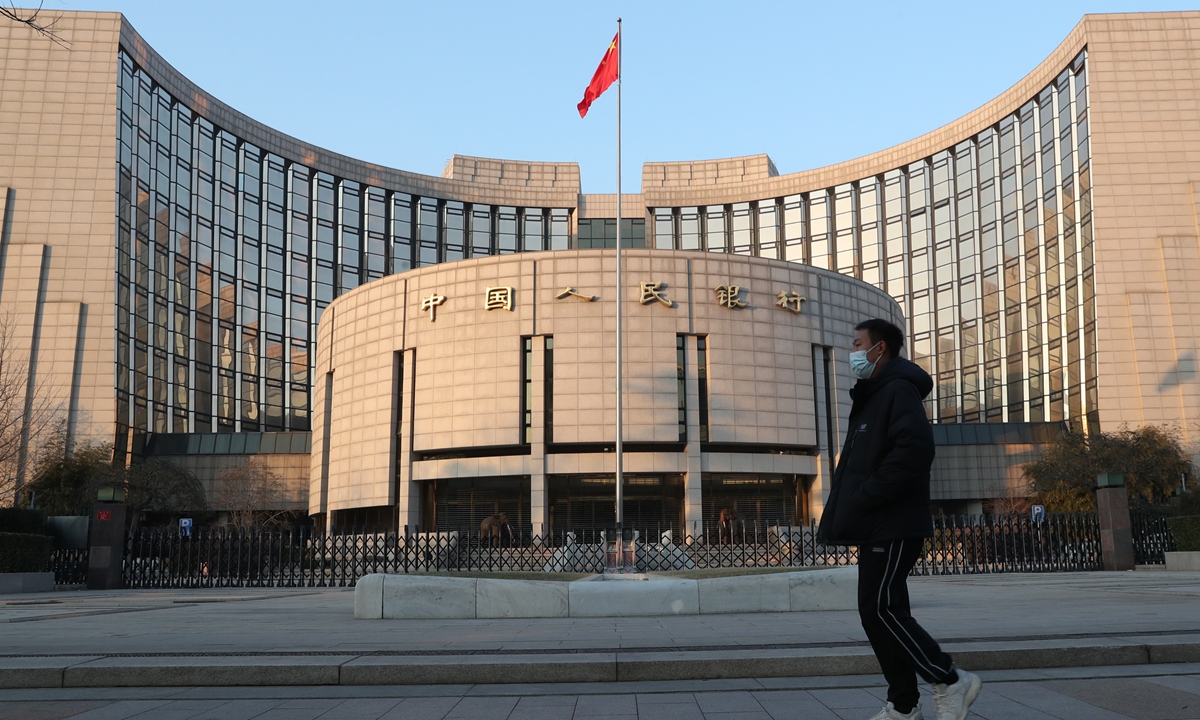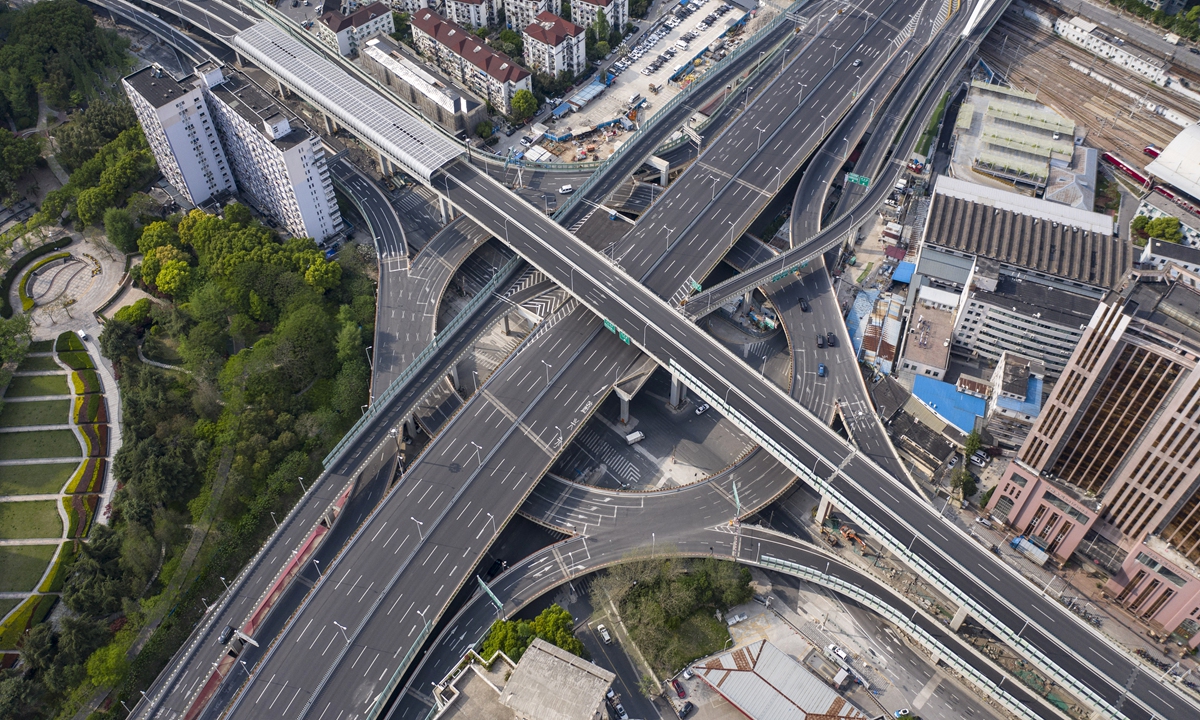
China's central bank Photo: CFP

Nearly-empty roads during a lockdown due to Covid-19 in Shanghai on Tuesday. Photo: VCG
With Chinese officials hinting at more than one high-level meeting recently that China will make flexible use of its monetary policy tools, and with China's financial powerhouse Shanghai still stuck in a grim battle against COVID outbreak, economists forecast the rollout of a reserve requirement ratio (RRR) cut very soon, on Friday at the earliest, as part of a basket of supportive policies to be rolled out this year which include interest rate cuts and loosening of restrictions on the property market in order to prevent the economy from sliding too hard.
A cut to the amount of cash that banks must hold as reserves, can release more than 1 trillion yuan ($157 billion) of capital and assist China's real economy, especially small enterprises that are currently facing a mixture of challenges ranging from logistics inconvenience triggered by coronavirus and bulk commodity price rises to unstable external market demands, they noted.
Chinese Premier Li Keqiang said at a State Council Executive Meeting on Wednesday that China will tap monetary policy tools such as lowering RRR for banks at an appropriate time to provide more financial support to small and micro companies hit hard by COVID-19.
This is the second time that Li hinted at the rollout of monetary policy stimulus recently at State Council meetings. On April 6, Li noted that China should use multiple monetary policy tools at the appropriate time and flexibly increase support for the real economy. He did not directly mention the RRR cut that day.
Sun Guofeng, an official from the central bank, also said at a press conference on Thursday that the PBC would use monetary policy tools like RRR cuts to increase the level of financial support for the real economy.
China has not launched any RRR cuts since December 2021, when the central bank cut RRR by 50 basis points. Last year, China launched two RRR cuts and in2020 when the coronavirus situation in Wuhan was similar to the recent Shanghai Omicron outbreak, China launched four RRR cuts in total.
Policy support Several economists predicted that China could launch RRR cuts as early as this week to pump up cash for markets which are currently troubled by growing challenges.
"The central bank might announce a cut to RRR by 0.5 percentage points within a week, possibly this Friday," Cao Heping, an economist from Peking University, told the Global Times on Thursday.
Zhao Qingming, a veteran financial expert, made a similar forecast, noting that the move will release 1.2 trillion yuan ($188 billion) of capital to revitalize markets.
According to Cao, the RRR cut should have been adopted in the first quarter against the backdrop of increasing anti-globalization and unilateralism in the West, the prolonged pandemic, and the Russia-Ukraine conflict putting downward pressure on the Chinese economy.
Those challenges have resulted in China facing strong headwinds in its bid to achieve its economic growth target of 5.5 percent for this year, he said, adding that the central bank should cut RRR two or three times in a row this year to effectively boost economic conditions.
However, several economists stressed that the effect of RRR cuts alone is limited in spurring the real economy, pointing out that although it can replenish capital in the banking sector, it might not be able to directly reach businesses, either because of weak demand or banks' reluctance to grant loans.
China's household loans, mostly mortgages, rose by 753.9 billion yuan in March, compared with a loan increase of more than 1.1 trillion-yuan in the corresponding period last year. China's growth of medium- and long-term company loans was also weak in the month, pointing to weak demand and bumpy capital transfers to the real economy.
As a result, economists predicted that China would launch a number of other financial stimulus policies as well, particularly those that can release capital for small enterprises directly, such as encouraging the issuance of collective bonds by small enterprises, Dong Shaopeng, a senior research fellow at the Chongyang Institute for Financial Studies at Renmin University of China, told the Global Times.
Zhao also said that one or two interest rate cuts are needed this year, as the government struggles to achieve the 5.5 percent GDP target set at the beginning of the year when there were no serious COVID flareups.
"The central bank's policy toolbox has many tools, such as refinancing, discount loans and so forth, but what China's economy needs the most is still large-scale interest rate cuts," Zhao told the Global Times.
Economic stabilizationThe economists also stressed that with the central government taking actions to remove disruptions, the impact of the coronavirus outbreak on China's economy will be short-term and limited, as they respond to a number of overseas media reports spreading alarm over China's economic difficulties.
Some foreign media outlets said that the recent coronavirus situation will damage China's economy and also exert a negative impact on the global economy. They particularly mentioned that COVID-19 would disrupt global supply chains and that global trade will be affected negatively as China's buying demand shrinks and logistics are disrupted.
So far, China's coronavirus-affected regions have gone to great lengths to minimize the impact of coronavirus control measures on supply chains, although a certain level of production disruption is inevitable.
The Shanghai Port informed the Global Times on Thursday that it is operating in a stable and orderly manner. The Yangshan Phase 4, the largest fully automated terminal in the world, saw cargo throughput increase by 27 percent year-on-year in March, the company noted.
As for trade fluctuation, Tian Yun, a Beijing-based economist, told the Global Times on Thursday that around 40 percent of China's imports are bulk commodities and it's normal for China to appropriately reduce purchases due to high international commodity prices, he said.
"The government order to put cities in closed-loop management shows that officials are putting people's health and safety at a more important position than short-term GDP growth," Tian said, adding that the COVID situation in Shanghai could drag down the country's whole year GDP by about 0.2 percent, a level seen as tolerable.
According to the analysts, the government might roll out a slew of measures to support particularly badly hit areas, including speeding up the easing of restrictions on the real estate sector, promoting key infrastructure projects and putting in place measures to stimulate the consumption sector.
Meanwhile, spending in infrastructure, including transportation, communication and green projects, as well as measures to stimulate consumer spending, are also in the pipeline.
On March 31, the National Development and Reform Commission reiterated the function of expanding effective investment for promoting stable and healthy economic development, urging all relevant departments to ensure that the 102 national key infrastructure projects be carried out as planned in the 14th Five-Year Plan period (2021-25).
China's Finance Minister Liu Kun also wrote in an official publication in April that China would launch larger scale tax cuts and fee reductions this year. In total, China is expected to reimburse and reduce taxes by about 2.5 trillion yuan in 2022.
Some overseas financial institutions stressed the appeal of Chinese markets despite the challenges. For example, a Fidelity International report noted that the valuation of some Chinese assets is still attractive, while the government is "capable of" adopting looser monetary and fiscal policies.





